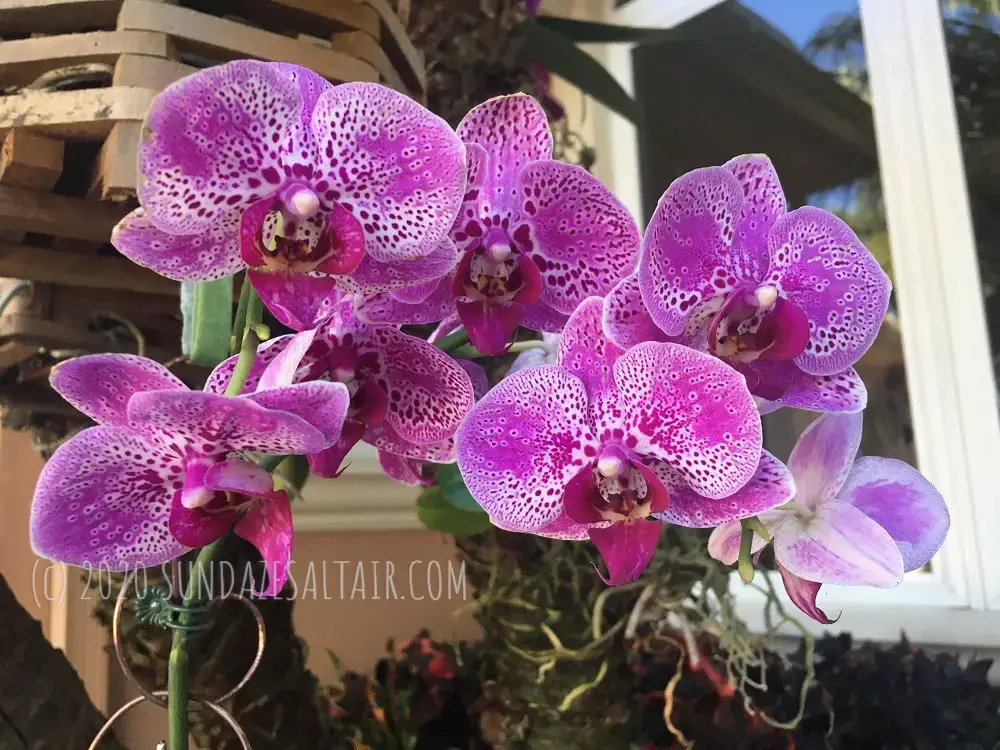When it comes to temperature, orchids are quite particular. They can’t tolerate too much heat or cold and prefer a steady, moderate temperature. So, what is the lowest temperature orchids can tolerate?
Orchids prefer temperatures between 60 and 80 degrees Fahrenheit. However, they can tolerate brief periods of cooler temperatures down to 50 degrees Fahrenheit. prolonged exposure to temperatures below 50 degrees will damage the plant and may kill it.
If you live in an area with cool winters, you’ll need to take steps to protect your orchid from the cold weather. The best way to do this is by growing your orchid in a pot that can be moved indoors when the temperature starts to drop.
Orchids are a very popular type of flower, and they come in many different colors. They can be found in almost any color except blue. One of the things that make orchids so popular is that they are very easy to care for.
Orchids do not require a lot of water, and they can tolerate a wide range of temperatures. The lowest temperature that orchids can tolerate is 50 degrees Fahrenheit. Orchids will still bloom at this temperature, but they will not last as long as they would if the temperature was higher.
If you live in an area where the temperature gets below 50 degrees Fahrenheit, you should consider getting an orchid that is already blooming. This way, you can enjoy the flowers for a longer period of time.
Phalaenopsis Temperature Tolerance
Phalaenopsis orchids are one of the most popular types of Orchidaceae due to their large, showy flowers. The genus Phalaenopsis is native to Southeast Asia and can be found in countries such as Thailand, Philippines, Malaysia, and Indonesia. In the wild, these orchids grow epiphytically on trees in shady areas with high humidity levels.
The ideal temperature range for Phalaenopsis orchids is between 18-24°C (64-75°F). However, these plants can tolerate a wide range of temperatures as long as they are not exposed to extreme conditions for extended periods of time. For example, short periods of exposure to temperatures below 10°C (50°F) will not damage the plant but prolonged exposure will cause the leaves to turn yellow and drop off.
Similarly, short periods of exposure to temperatures above 30°C (86°F) will not damage the plant but extended exposure will cause the flowers to wilt and drop off.
In general, it is best to keep your Phalaenopsis orchid in an environment that has a consistent temperature and moderate humidity levels. If you live in an area with drastic changes in temperature (such as extreme heat or cold), it is best to find a location inside your home that is more stable.
You can also increase the humidity around your plant by placing it on a pebble tray filled with water or misting it regularly with distilled water.
Cymbidium Orchid Temperature Tolerance
Cymbidium orchids are some of the most popular and well-loved orchids in the world. And for good reason! They’re easy to care for, they bloom prolifically, and they come in a wide range of colors and sizes.
Cymbidiums are also pretty tolerant when it comes to temperature fluctuations. Here’s what you need to know about cymbidium orchid temperature tolerance.
Cymbidiums originate from tropical and subtropical regions of Asia.
In their natural habitat, they experience relatively warm temperatures year-round. daytime temperatures hover around 80 degrees Fahrenheit, with nighttime temperatures dipping down into the 60s. However, cymbidiums can also tolerate cooler temperatures – as low as 50 degrees Fahrenheit – for short periods of time without any ill effects.
When it comes to your home, aim to keep your cymbidium orchid happy by providing daytime temperatures between 70 and 85 degrees Fahrenheit, and nighttime temperatures between 55 and 65 degrees Fahrenheit. If your home is on the cooler side, you may need to provide additional humidity through misting or using a humidifier. As long as you provide adequate humidity and don’t let the temperature dip too low at night, your cymbidium should do just fine!
Orchid Temperature Range
Orchids are one of the most popular flowers in the world and are known for their beauty and variety. There are over 25,000 species of orchids, making them one of the largest families of flowering plants. Orchids grow in a wide range of climates, from the hot tropics to cold mountain regions.
However, most species require warm temperatures to thrive.
The ideal temperature range for orchids is between 65 and 80 degrees Fahrenheit (18-27 degrees Celsius). This range allows the plants to develop strong roots and flower buds while also preventing them from overheating or becoming too dry.
While some orchid species can tolerate brief periods outside of this temperature range, it is generally not advisable to keep them outside of their optimal conditions for long periods of time. If you live in an area with cooler temperatures, you may need to provide additional heat for your orchids using a heating mat or grow lights. Conversely, if you live in a very warm climate, you may need to take steps to prevent your orchids from getting too much heat, such as by providing shading or increasing air circulation around the plants.
By understanding the ideal temperature range for orchids, you can ensure that your plants are healthy and blooming beautifully.
What Temperature is Too Hot for Orchids
Orchids are a tropical plant, and as such, they prefer warm temperatures. In general, an temperature of around 70-85 degrees Fahrenheit is ideal for most Orchids. However, there are some Orchids that can tolerate higher temperatures for short periods of time.
For example, the Phalaenopsis Orchid can tolerate temperatures up to 95 degrees Fahrenheit for short periods of time without any damage.
However, it is important to note that Orchids can be damaged by both high and low temperatures. If the temperature gets too hot, the leaves of the Orchid will start to turn brown and wilt.
This is usually a sign that the plant is suffering from heat stress and needs to be cooled down immediately. On the other hand, if the temperature gets too cold, the leaves of the Orchid will turn black and drop off. This can happen even if the temperature only dips below 50 degrees Fahrenheit for a short period of time.
In general, it is best to err on the side of caution when it comes to Orchids and temperature.
Dendrobium Temperature Range
Orchids are a very diverse group of plants, with species that can be found in tropical rain forests to high alpine meadows. With such a wide range of habitats, it’s not surprising that there is also a wide range in the temperature requirements of different Orchid species. In general, most Orchids prefer warm temperatures during the day and cooler temperatures at night.
However, there are also a number of Orchid species that come from areas with more extreme conditions, such as hot deserts or cold mountain regions.
One Orchid genus that is well known for its ability to tolerate a wide range of temperatures is Dendrobium. This genus includes both terrestrial and epiphytic species, which means they can be found growing in both soil and on trees.
Dendrobiums originate from all over Asia, including India, China, Malaysia, and Indonesia. Due to this wide range in their natural habitat, they have developed a great deal of heat tolerance. Many Dendrobium species can withstand daytime temperatures up to 95°F (35°C) as long as they have access to good air circulation and moisture.
At night, these same plants can tolerate temperatures as low as 50°F (10°C).
When grown indoors, Dendrobiums should be given bright light but not direct sunlight. They also need an evenly moist environment but one that allows the potting mix to dry out somewhat between waterings.
As long as these basic needs are met, most Dendrobiums will do well at average household temperatures ranging from 68-74°F (20-23°C) during the day and 60-66°F (15-19°C) at night.
Dendrobiums are one of the most varied groups of orchids in terms of their appearance and size with some looking very much like miniature Phalaenopsis while others look quite different with long stems carrying many small flowers along their length The flowering season for many dendrobium hybrids is spring although there are some cultivars which will flower almost continuously throughout the year if provided with optimum conditions . Flowering generally lasts around 4 – 6 weeks per inflorescence but may last longer under ideal conditions .
Most dendrobiums require slightly cooler nighttime temperatures than daytime temps for best results , so somewhere between 10 – 15 degrees difference works well . A drop in temperature at night signals the plant that it’s time to start forming flower buds , so without this change you may not get any blooms .

Credit: www.sundazesaltair.com
What Temperature Should You Bring Orchids Inside?
Orchids are a tropical plant, and therefore thrive in warm temperatures. The ideal temperature for orchids is between 70-85 degrees Fahrenheit. However, they can also tolerate slightly cooler temperatures, as long as they are not exposed to drafts or sudden changes in temperature.
If you bring your orchid inside during the winter months, make sure to place it in a location that is away from any windows or doors where cold air can enter.
What is the Lowest Temperature for Phalaenopsis?
Phalaenopsis, also known as moth orchids, are a popular type of orchid. They are easy to care for and have long-lasting blooms. Phalaenopsis thrive in humid environments with temperatures ranging from 65-85 degrees Fahrenheit.
The minimum temperature for Phalaenopsis is 50 degrees Fahrenheit. If the temperature drops below 50 degrees, the leaves will start to turn brown and the flowers will fall off.
What Happens If an Orchid Gets Too Cold?
If an orchid gets too cold, it will go into shock and may die. When an orchid is in shock, its leaves will turn black and it will stop blooming. If you think your orchid is in shock, bring it inside and place it in a warm room until it recovers.
Can You Keep Orchids in an Unheated Greenhouse?
Orchids are one of the most popular houseplants, but they can be finicky and difficult to care for. Many people don’t realize that orchids can also be grown in an unheated greenhouse. With a little extra care, you can successfully grow orchids in an unheated greenhouse!
One of the most important things to remember when growing orchids in an unheated greenhouse is to provide them with adequate ventilation. Orchids need a lot of air circulation to thrive, so make sure your greenhouse has plenty of vents and windows that can be opened to let in fresh air.
Another important consideration is humidity.
Orchids prefer high humidity environments, so you’ll need to take steps to increase the humidity in your greenhouse. One way to do this is by misting your plants regularly with a spray bottle filled with water. You can also set up a humidifier in your greenhouse, or place trays of water around the perimeter of the room.
When it comes to watering, it’s best to err on the side of caution and not overwater your orchids. Allow the top inch or two of soil to dry out before watering again. And always use lukewarm water instead of cold water, which can shock delicate orchid roots.
Finally, make sure you’re providing your plants with enough light. Orchids need bright light but direct sunlight can scorch their leaves, so try placing them near an east-facing window where they’ll get indirect sunlight throughout the day. If you have trouble providing enough light, you may need to invest in some grow lights specifically designed for indoor plants.
With proper care, it’s possible to grow healthy and beautiful orchids in an unheated greenhouse!
Very Cold Winter Temperatures & Orchid Care
Can Tulips Survive in Low Temperatures During Transplantation?
Transplanting sprouted tulips requires careful consideration of low temperatures. While robust tulip bulbs can handle cold climates, sprouted tulips are more vulnerable. When moving them to a new location, protect the young sprouts from frost, as freezing temperatures may damage or kill them. Proper care, such as providing adequate insulation and avoiding sudden temperature fluctuations, will increase the chances of survival for tulips during transplantation in chilly conditions.
Conclusion
Orchids are a very delicate flower, and they can be easily damaged by extreme temperatures. The lowest temperature that orchids can tolerate is 50 degrees Fahrenheit. Orchids will start to experience damage at this temperature, and their flowers will begin to wilt.
If the temperature drops any lower, the orchids will die. This is why it is important to protect your orchids from cold weather, and make sure they are kept in a warm environment.






